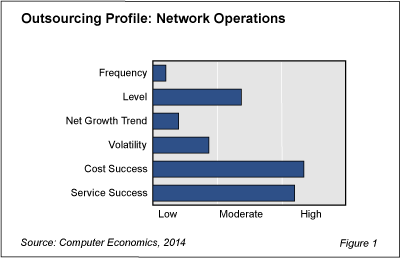IT organizations are having great success outsourcing network operations, but that has not translated into widespread adoption of this practice.
Our study, Network Operations Outsourcing Trends and Customer Experience, rates the frequency of network outsourcing among IT organizations as very low, as shown in Figure 1 from the study. The percentage of companies turning this function over to service providers lags behind the rate at which companies are outsourcing many other IT functions.

We rate the outsourcing level as moderate, however. The level is an estimate of the amount of total workload being outsourced. This finding indicates organizations that outsource network operations are outsourcing only part of their operations, but they are also not merely using these services to fill in around the gaps. They are turning over an average volume of workload on a relatively steady basis.
The profile chart next rates the net growth trend and volatility of network operations outsourcing. Both are rated as low on our scale. The net growth trend is the percentage of organizations increasing the amount of work they outsource over the previous year minus the percentage decreasing the amount of work outsourced. The volatility is a measure of how many organizations are changing the amount of work outsourced, either up or down. Together, these metrics show that the outlook for network operations outsourcing is for relative stability and slow growth.
Finally, the analysis rates the cost success of network operations outsourcing as high and the service success as high. The customer experience is strong. The percentage of organizations that find cost is lower or about the same as operating their own networks is higher than for the cost experience of other outsourced IT functions. The percentage that find service levels the same as or better than performing the work in-house is also relatively high. Customers are happy with cost and service levels, and customer dissatisfaction is not the cause of the low frequency and net growth trend.
While network operations outsourcing may be a relatively low priority for many organizations in North America today, that is far from the case in Europe and the Asia-Pacific regions. U.S. and Canadian enterprises have been reluctant to outsource critical data network functions such as network management to outside providers, as this study shows. However, it is likely North American enterprises will follow their overseas counterparts as cloud computing expands and IT departments seek greater cost-savings and more flexibility.
To help IT executives understand their options, the full study examines adoption trends in the outsourcing of network operations. We report on the percentage of organizations outsourcing network operations (frequency), the average amount of work outsourced (level), and the change in the amount of work being outsourced (trend and volatility). We also present the cost- and service-success ratings, which provide insight into the potential risks and rewards IT organizations take in turning to outside service providers. We show how these trends differ by organization size and sector, and provide recommendations for engaging with network outsourcing service providers.
This Research Byte is a brief overview of our management advisory on this subject, Network Operations Outsourcing and Customer Experience. The full report is available at no charge for Computer Economics clients, or it may be purchased by non-clients directly from our website (click for pricing).

